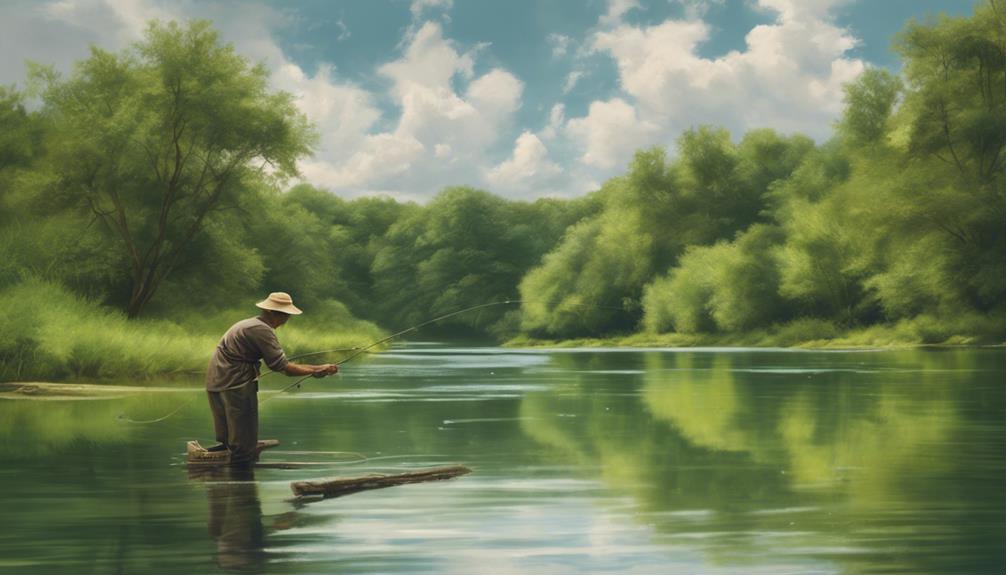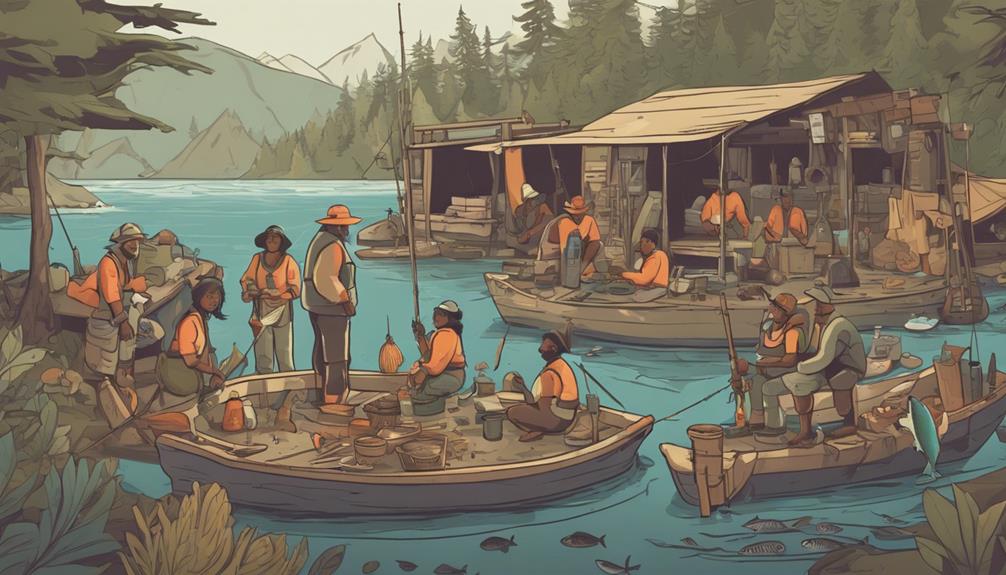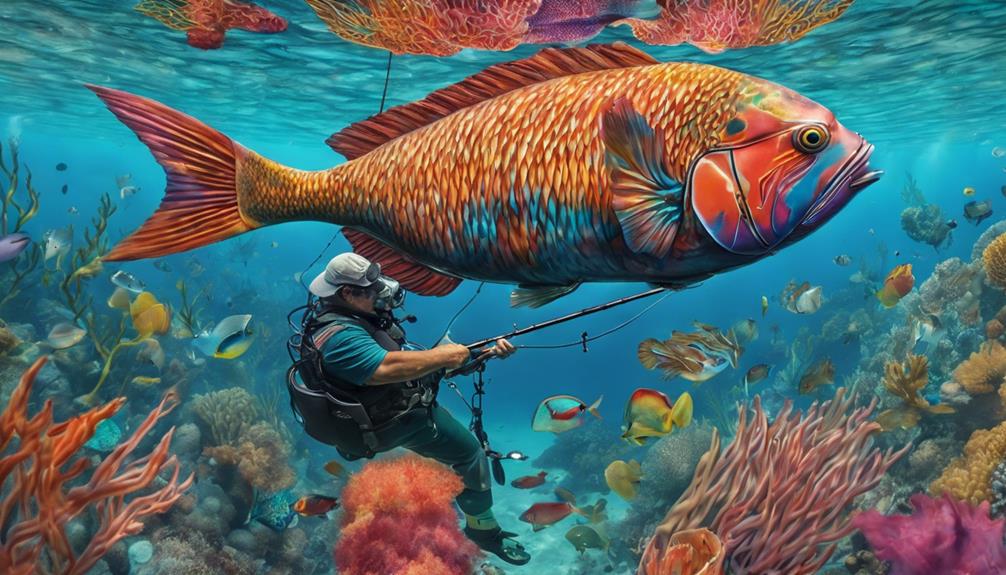When it comes to successful salmon fishing, mastering a few key tips can make all the difference in your catch rate. Understanding salmon behavior is crucial, but it's just the tip of the iceberg.
You'll need to delve into choosing the right gear, mastering the art of casting, and identifying prime fishing spots to truly elevate your game.
Stick around to uncover the secrets that will have you reeling in those prized salmon with finesse.
Understanding Salmon Behavior
To catch more salmon, observe their behavior closely and adapt your fishing techniques accordingly. Understanding their feeding patterns and spawning behavior is crucial for a successful fishing trip. Salmon are known to have different feeding patterns based on the time of day and water temperature.
In the early morning or late afternoon, they're more active near the surface, making them easier to target with lures or flies. However, during midday or in colder water, they tend to swim deeper, requiring you to adjust your bait's depth accordingly.
When it comes to spawning behavior, it's essential to know that salmon tend to migrate to freshwater streams and rivers to reproduce. During this time, they become less interested in feeding and more focused on finding suitable breeding grounds. This can affect their willingness to bite, so it's crucial to use lures or baits that mimic the movements of injured prey to trigger a strike response.
Choosing the Right Gear
Understanding salmon behavior is essential when it comes to choosing the right gear for your fishing expedition. Selecting the proper equipment can significantly impact your success in catching salmon. To start, consider the type of salmon you're targeting, as different species may require specific gear. For example, if you're going after larger Chinook salmon, you'll need heavier rods and reels compared to the gear used for smaller Coho salmon.
When selecting equipment, pay close attention to the fishing rod and reel. Opt for a medium to heavy-action rod that can handle the weight and fight of salmon. Pair this with a quality reel that has a smooth drag system to prevent the fish from breaking free. Additionally, make sure to spool your reel with a high-quality fishing line that can withstand the strength of salmon.
In addition to rods and reels, choosing the right lures or bait is crucial. Depending on the fishing conditions and the behavior of the salmon, you may need to use different lures to entice the fish. Experiment with various types of lures, such as spoons, spinners, or plugs, to see what works best.
Lastly, mastering the proper technique is just as important as having the right gear. Practice your casting and reeling skills to ensure a successful fishing trip. By combining the right equipment with proper technique, you'll be well on your way to a fruitful salmon fishing experience.
Mastering the Art of Casting
Master the art of casting with precision and finesse to enhance your salmon fishing skills. To become a proficient angler, focus on honing your casting technique through consistent practice. Here are three key tips to help you improve your casting skills:
- Perfect Your Casting Technique:
Practice is essential to mastering the art of casting. Start by learning the basic casting techniques such as overhead casting, roll casting, and sidearm casting. Experiment with different casting styles to find what works best for you. Remember to practice regularly to develop muscle memory and improve your accuracy.
- Maintain Line Control:
Effective line control is crucial for accurate casting. Ensure that you have a firm grip on the fishing line to control its movement during casting. Practice adjusting the amount of line released during your cast to target specific areas where salmon might be present. By maintaining proper line control, you can increase your chances of a successful catch.
- Aim for Accuracy:
Accuracy is key when casting for salmon. Focus on your target and aim your cast accordingly. Pay attention to factors like wind direction and current speed, which can affect the trajectory of your cast. With practice, you'll be able to cast with precision and increase your chances of hooking that prized salmon.
Identifying Prime Fishing Spots
Enhance your salmon fishing success by pinpointing prime fishing spots along the riverbanks and in the depths of the water. When seeking out the best locations to reel in that prized catch, pay close attention to tidal currents and underwater structures.
Tidal currents play a crucial role in attracting salmon, as they carry food and create areas of turbulence where fish like to gather. Look for spots where the current changes direction or speed, as these are often hotspots for salmon activity. Additionally, underwater structures such as rocks, fallen trees, or deep holes provide shelter for salmon and offer ideal feeding grounds.
To make the most of tidal currents, consider fishing during the incoming or outgoing tide when the water movement is strongest. During these times, salmon are more likely to be actively feeding and moving along the river. Be mindful of how the current interacts with underwater structures, as these areas can create eddies and pockets of calm water where salmon rest before continuing their journey.
When scouting for prime fishing spots, observe the water's surface for signs of activity such as jumping fish or swirling eddies. These visual cues can guide you towards areas where salmon are congregating. By understanding the influence of tidal currents and underwater structures, you can strategically position yourself for a successful salmon fishing expedition.
Perfecting Your Presentation Techniques
Refine your approach to salmon fishing by honing your presentation techniques for maximum effectiveness. When it comes to attracting salmon, how you present your bait can make all the difference. To improve your skills in this area, consider the following tips:
- Practice Makes Perfect: Just like with any skill, practice is key to mastering your presentation techniques. Spend time experimenting with different casting angles, speeds, and depths to see what works best in different conditions. The more you practice, the more confident and skilled you'll become.
- Timing Your Approach: Timing is crucial when it comes to presenting your bait to salmon. Pay attention to factors like water temperature, weather conditions, and the time of day to determine the best times to fish. Salmon are more likely to be active and feeding during certain times, so adjusting your presentation technique accordingly can greatly increase your chances of success.
- Stay Patient and Observant: Sometimes, the key to a successful presentation lies in being patient and observant. Take the time to watch the water for signs of salmon activity, such as jumping fish or feeding frenzies. By observing their behavior, you can tailor your presentation techniques to better match what the salmon are looking for.
Handling and Releasing Salmon Safely
When it comes to handling and releasing salmon safely, prioritizing the well-being of the fish is essential for conservation efforts. By practicing proper release techniques and following conservation practices, you can help ensure the sustainability of salmon populations for future generations.
First and foremost, when handling salmon, it's crucial to take handling precautions to protect the fish's health. Always wet your hands before touching the fish to avoid damaging their protective mucus layer. Avoid squeezing the fish tightly and support its body properly to prevent injury. If you need to unhook the salmon, use needle-nose pliers to minimize handling time and reduce stress.
When releasing the salmon back into the water, consider using barbless hooks to make the process easier and less harmful to the fish. Hold the fish gently in the water, facing it upstream, and allow it to regain its strength before letting it swim away. Avoid dropping the fish or tossing it back into the water, as this can cause trauma or harm.
Weather and Water Conditions

Considering the weather and water conditions is crucial for a successful salmon fishing experience. To maximize your chances of a fruitful outing, here are three key factors to keep in mind:
- Tackling Tides
When planning your salmon fishing trip, understanding the tides is essential. Salmon are highly influenced by tidal movements, as they use these currents to navigate and feed. Monitoring tide charts and knowing the best times for fishing during the high or low tides can significantly increase your chances of hooking a salmon.
- Weather Watching
Keeping an eye on the weather forecast is vital before heading out for your salmon fishing adventure. Unfavorable weather conditions such as strong winds, heavy rain, or storms can make fishing challenging and potentially dangerous. On the other hand, certain weather patterns like overcast skies or light rain can sometimes improve salmon activity. Be prepared to adjust your fishing strategy based on the weather conditions.
- Water Conditions
The clarity and temperature of the water play a significant role in salmon behavior. Salmon are sensitive to changes in water conditions, so understanding factors like water clarity and temperature can help you select the right bait and fishing technique. Additionally, knowing how recent rainfalls may have affected the water flow and visibility can guide your fishing approach for the day.
Planning for Success
To ensure your salmon fishing expedition is a success, meticulous planning is essential. Start by focusing on tackle preparation. Make sure your fishing gear is in top condition, checking your rods, reels, lines, and lures for any damage. Organize your tackle box efficiently, ensuring easy access to different types of bait and lures based on the salmon species you're targeting. Having a well-stocked and organized tackle box can save you valuable time on the water.
Next, consider timing strategies. Research the best times of the year and day to fish for salmon in your chosen location. Factors such as salmon migration patterns, water temperature, and weather conditions can all influence the optimal timing for a successful catch. Plan your fishing trip during peak salmon season when they're most active and abundant. Additionally, pay attention to tidal movements and moon phases, as these can impact salmon behavior and feeding patterns.
Frequently Asked Questions
What Are the Best Types of Bait to Use When Salmon Fishing?
When salmon fishing, the best lures to use are typically ones that mimic the natural prey of the salmon, such as spoons, spinners, or plugs. Proper techniques involve varying your retrieval speed and depth to attract the fish.
Are There Any Specific Regulations or Restrictions to Be Aware of When Salmon Fishing?
When salmon fishing, it's crucial to follow fishing regulations and obtain necessary permits. Be aware of catch limits and participate in conservation efforts to protect salmon populations.
Regulations may vary by location, so always research local rules before heading out. By respecting these guidelines, you can enjoy a successful and sustainable fishing experience while helping to preserve the salmon population for future generations.
How Can I Effectively Clean and Preserve My Salmon Catch?
When you catch salmon, proper handling is crucial for freshness. After catching, clean the fish promptly to maintain quality. Remove scales, guts, and bloodline carefully. Rinse with cold water.
To preserve your catch, store it in a cool place or on ice. For longer storage, consider vacuum-sealing or freezing. Properly cleaned and stored salmon will taste delicious when cooked.
Are There Any Important Safety Tips to Keep in Mind While Out on the Water Salmon Fishing?
When you're out on the water salmon fishing, remember safety precautions are crucial. Always have emergency kits onboard and be prepared for any situation.
Keep an eye on weather conditions and plan accordingly. Navigation tips can help you stay safe and find the best spots.
Prioritize your safety above all else to ensure a successful fishing trip.
Can You Provide Some Advice on How to Properly Store and Transport Salmon After a Successful Fishing Trip?
When it comes to storing your freshly caught salmon, remember to keep it chilled in a cooler with ice packs to maintain its freshness.
Avoid leaving it out in the sun for too long.
For transportation, carefully pack the salmon in a sealed container to prevent any leaks or spills in your vehicle.
Always prioritize keeping the fish cold to ensure it stays safe to eat once you get home.
Conclusion
Now that you have mastered these top tips for successful salmon fishing, you're ready to hit the water with confidence. Remember to observe salmon behavior, choose the right gear, cast effectively, and identify prime fishing spots.
By perfecting your presentation techniques and handling salmon safely, you can increase your chances of a successful catch. Keep an eye on weather and water conditions, plan ahead, and get ready for a rewarding fishing experience.
Happy fishing!



